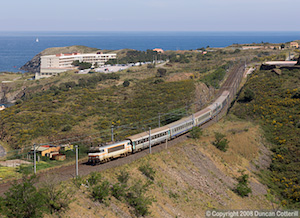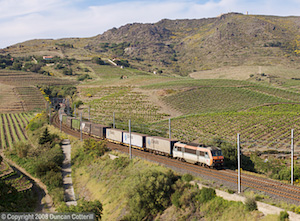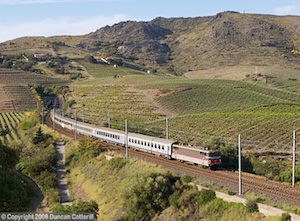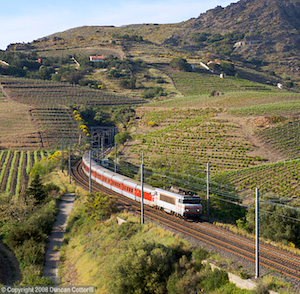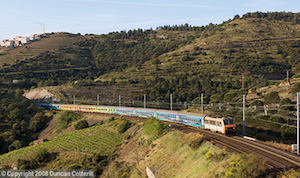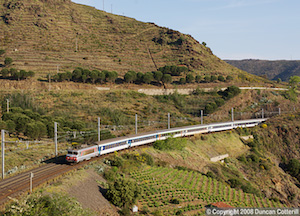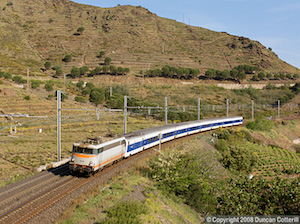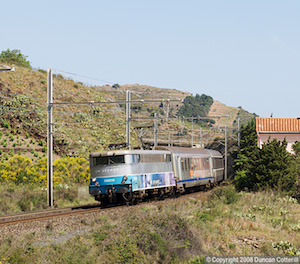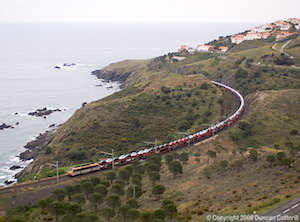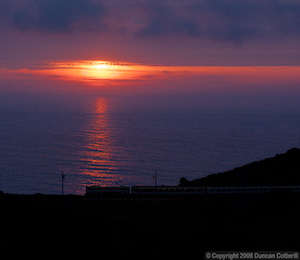Rails Along The Cote Vermielle
07 - 11 May 2008
Report by Duncan Cotterill
Introduction
After a long trip to the Czech Republic in April, I was looking for something different to do on my next escape abroad. Chris Wilkinson suggested the Perpignan - Cerbere line in the south of France and a few days in the warm Mediterranean sunshine certainly appealed. So with visions of hot weather and bright sunlight to the fore, it was off to explore the electrified main line running down to the Spanish frontier. It had been almost ten years since my last trip to France so a return visit was long overdue.
Like so many places, getting around this part of France by train isn’t very practical, not because of the distances from the stations to the photo positions, they are manageable, but because of the sheer lack of trains at critical times of the day. Hiring a car was the only viable method of getting about, not least as my accommodation was right next to the line but nowhere near a station.
The Line
The character of the French Mediterranean coastline changes dramatically as it approaches the Spanish border. The flat coastal plain and broad sandy beaches give way to more rugged terrain where the eastern end of the Pyrenees plunges down to meet the sea. This is the Cote Vermielle or Vermillion Coast, an area of sheer cliffs, rocky coves, precipitous mountainsides and terraced vinyards. It isn’t ideal territory for railway building but the alternative to a coastal route would have involved going over or under the Pyrenees, a far more daunting prospect.
After an easy run south across the plains from Perpignan, the line approaches the coast and starts climbing between Argeles sur Mer and Collioure. From Collioure, the railway turns slightly inland, running behind the town of Port Vendres and then following a succession of valleys, linked by tunnels, to avoid the most difficult sections of the coastline. South of Banyuls sur Mer, the line emerges from the last tunnel and runs along the clifftops for the final few kilometres to Cerbere.
French and Spanish railways exchange northbound traffic at Cerbere and southbound traffic at Port Bou, just across the border. Interchange involves a change of gauge as well as a change of operator and there are large yards at both locations to enable reguaging or transhipment of freight. Passengers have to change trains unless they are travelling on one of the through Talgo services. The Talgos are regauged at Port Bou irrespective of the direction of travel.
Passenger Services
Passenger traffic is not particularly intense. For one of the only two main lines linking France and Spain, there are remarkably few long distance trains. The principal international daytime services consist of two pairs of Talgos. The “Catalan Talgo” runs from Barcelona to Montpellier and back, going north in the morning and returning in the evening. The “Mare Nostrum” links Cartagena with Montpellier and heads north in the evening then returns to Spain the following morning. There are also a few long distance internal services that stop at the border, notably a day and an overnight train from Paris to Port Bou and an overnight from Metz and Strasbourg to Port Bou. TGVs don’t run south of Perpignan so all the trains mentioned above are loco hauled. Motive power tends to be class BB7200 or BB26000 but veterans of class BB9300 can also appear occasionally. Details of the locos seen on each train can be found by following the link to the Sightings page.
Local services are mainly loco hauled although there are a few push-pull workings and the occasional EMU. Again the service is not particularly intense with long gaps outside the peak periods. Class BB9300 work most of the hauled services with the occasional class BB7200 lending a hand. The push-pull sets are paired with class BB8500 locos, many of which appear to belong to the freight sector. The loco is usually at the north end of push-pull rakes but one working was seen the other way round. A few southbound locals continue across the border to Port Bou but most terminate at Cerbere. All northbounds start at Cerbere with Spanish trains providing the few cross-border services.
As this is France there are many variations to the pattern with different passenger services on weekdays, Saturdays, Sundays, holidays, days before, after and in between holidays etc. Some days see timetabled relief trains and the “regular” trains don’t run on others, or they may run in the same slot but as an ECS working. Every day seems to be different so careful scrutiny of the timetable is essential if you don’t want to be caught out.
Freight Traffic
Freight volumes seem reasonable until you remember that this is one of only two main lines linking Spain with the rest of Europe. Around half a dozen daylight trains in each direction doesn’t then sound so good. Much of the traffic is intermodal with containers, swap bodies and complete lorry trailers all being seen in significant quantities.
Unlike some places, the freights tended to be predictable, turning up at roughly the same time each day. See the table on the Sightings page for details. The public holiday on 8 May didn’t seem to affect the number of trains and Saturday 10 May was also normal. However, no freights were seen on Sunday 11 May. The vast majority of trains were worked by class BB26000 “Sybics” but occasionally class BB7200 also appear. An ECR class 66 worked a Ford car parts train north from Cerbere in the early morning.
Photography
This line lends itself to photography during the summer months as it runs north to south and the busiest periods are early morning and late afternoon / early evening. The sun is too high and in the wrong place during the middle of the day so there’s time to relax and catch up on lost sleep. It’s worth noting that this part of France is only three degrees east of Greenwich so the sun doesn’t reach its zenith until almost 14:00. This means that sunrise in mid May is a manageable 06:30 and the light remains useable until well after 11:00. Conversely, it’s not worth going out in the afternoon before 16:00 but you can keep photting until quite late.
My visions of wall to wall sunshine were well wide of the mark. It was unbroken cloud most of the time with plenty of rain as well. This may have been the south of France but it felt more like the west coast of Scotland! The sun did shine on Wednesday afternoon and Thursday morning and for a few glorious minutes at sunrise on Friday but that was it. By the time I’d found the best positions on the coastal section, terminal dullness had descended so the shots will have to wait for another day.
Comment
Ten years is a long time between visits to our nearest foreign destination but as the trip progressed it became clearer why I preferred visiting other countries. France is incredibly foreign, far more so than Germany, Switzerland, Spain or the Czech Republic. Things that you take for granted prove not to be the case. For example, you would think it would be relatively easy to fill the car with fuel in a large town like Perpignan before returning it to the airport. Wrong! There are plenty of petrol stations open on a Sunday but they are automated and only take their own obscure payment cards. Apparently there is one petrol station in the whole place where you can actually buy fuel with real money or credit cards. However, it’s on the opposite side of town to the airport and I didn’t find it. Now Europcar will fleece me around 3 Euros a litre to fill the tank. Something I could well do without.
As it was a holiday weekend, I couldn’t get a reasonably priced room at a hotel and ended up in a small flat in a holiday village, a sort of Butlins sur Mer. It was ideal for early starts but you were expected to supply your own soap, towels and toilet paper. At least they provided sheets, but summer visitors are apparently expected to bring their own.
At least I didn’t run into problems with the authorities like some people have in France. All the normals stop to photograph the coastline around Cerbere so somebody hanging around with a camera doesn’t seem to attract the same level of suspicion as it might do in other places.
On a more positive note, the scenery between Collioure and Cerbere is superb and there are some really excellent photo positions along the coast and inland. There weren't as many trains as might be expected on a prime international route but it was still busy enough to keep me happily occupied when the sun shone. The variety of motive power and variations in livery also contributed to the interest.
France and Spain will be linked by a high-speed line from early 2009. The new route will link Perpignan and Figueres via an 8 km tunnel under the Pyrenees and has been designed to carry both passengers and freight. This will almost certainly reduce the volume of traffic using the existing route but it's not clear how much freight will use the new line from day one. A gauge change will still be necessary at Figueres until the standard gauge line from Barcelona is completed at some time in the future.
In short, Perpignan to Cerbere is a great section of railway to photograph but France is really hard work. I do want to go back to get the coastal shots but maybe I'll do it from the Spanish side next time. With the high-speed line on the horizon, it's probably not a good idea to wait another ten years before going back!
